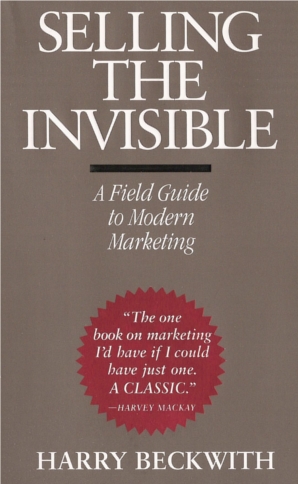
If you think about the title of the book for a minute you’ll start to understand what this book is all about. Suppose your company sold mobile phones and maintenance contracts for the phones. How would you pitch each product to a potential customer? You’d hand them the phone, let them feel the quality, maybe make a call or two so they could hear the excellent audio and reception, show them how easy it is to use, etc., etc. What would you hand them to sell the maintenance contract? They can’t feel it or see it or anything. It’s invisible. You can’t hand someone a service and let them “kick the tires.” Now do you understand the title?
The author has collected together an excellent set of concepts and examples which contrasts clearly the differences and challenges of selling services. You can examine a product but you can’t examine a service. What does that mean? There’s a chapter titled “Risky Business” that tells you, on one page. both to look at purchasing your service from the perspective of the potential client and also what’s often an important decision-making factor. Have you ever made a mistake on an assignment? Read the chapter called “To Err Is an Opportunity.” Chapter after chapter goes after one idea and makes a point. What I found as I read the book is that I’d apply what I was reading to what I was actually doing in my business. I started taking notes about each chapter and what I needed to do. We all need to build a sales and marketing plan (if you don’t think so then just read the chapter titled “Fallacy: Build a Better Mousetrap”) and I found that this book communicated the breadth of what we need to consider, a bit of how-to advice, and what not to do because you won’t get the results you expect.
Why is this stuff important? Why do we care? Because selling a service is different than selling a product, and we’re selling a service! For example, there’s a chapter titled “Last Impressions Last.” We’ve all heard about the importance of making a good first impression. Do you also focus on the last impression you give to a client as you’re wrapping up a consulting contract? When do you stop planning and start executing? Read the chapter called “Fallacy: Strategy is King.” Many things that we do we think are obvious and just common sense. Some are in fact good ideas and sound approaches but perhaps others aren’t. Do you think that the better you are the better your business will be? Read the chapter “Being Great vs. Being Good.” These are just a few examples of what you’ll get out of this book.
The book is organized into major sections with many chapters per section. Each chapter is very small, typically just a page or two (there are 172 chapters and 250 pages). Each chapter drives home one key point and often includes real-world examples. Since they’re small they’re quick to read. They’re fun to read. The book is perfect for those spare few minutes we get occasionally during our busy days. It’s perfect for a trip or a commute. You get good material and you don’t need to dedicate a solid hour of focused concentration to get it.
For the most part consultants sell services. We sell our expertise. We need to know how. And probably most of us have a limited sales and marketing budget. This book is not a cookbook but a great collection of tips, tricks, and advice to help us all improve how we sell our invisible product.
